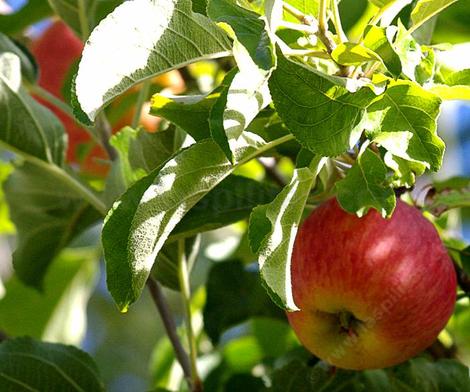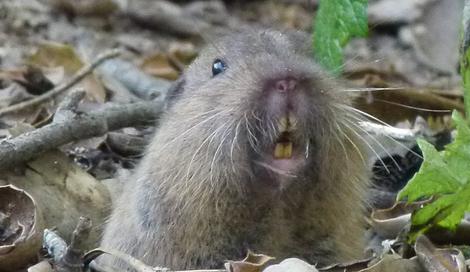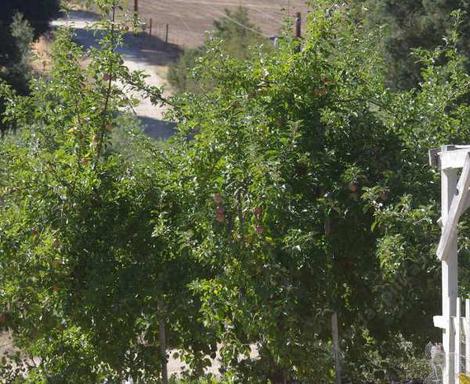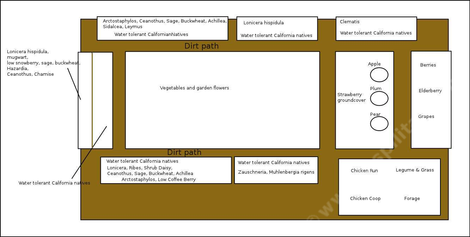How to Design a Vegetable and Fruit Garden with California Native Plants.
Integrating California native plants with a fruit and vegetable garden can be a good thing. Growing California native plants with vegetables and fruits helps the production of the garden, adds variety to the garden, attracts birds, attracts butterflies, attracts predators and parasites, attracts pollinators, adds interest to the garden, and preserves genetic diversity, for starters.Yes, it can work. There are just a few design ideas we have found when creating this type of garden, that will allow this combination of plants to grow harmoniously.
We try to keep plants with similar needs together. So plants that need full sun we put together in one sunny spot, and plants that need shade we place together in a shady spot. Also, plants with similar water needs we try to group together, in a row or a cluster, depending on the design plan.
The most important thing we have had to remember (much to our
chagrin) is that plants with high input needs (in terms of water,
disturbance, and amendments) should be grouped together.
By trial and error we have learned that, over the long-term, The vegetable and fruit gardens must be centrally located. Not for the reason that you may be thinking, in that it is closest to the house, or easier to access, but for the fact of the contrasting needs of common vegetable and fruit plants, and California native plants. In ever widening circles or rectangles (or whatever shape your garden) the plant needs should decrease as you move away from the center.
Scientists do not know, as of yet, the complete underlying mechanisms of growth, and life strategies of plants, but the life strategies of California native plants seem to be intimately connected to their relationships with mycorrhizae, in most cases. This does not seem to be true of most garden fruits and vegetables. California native plants, for the most part, form obligate symbiotic relationships with long-term mycorrhizal fungi, and/or highly specialized mycorrhizal fungi. In contrast, most garden fruits and vegetables are either non-mycorrhizal, facultatively mycorrhizal, utilize "weedy" mycorrhizal fungi, or actually kill the existing native mycorrhizal fungi. This is the current theory of one of the mechanisms underlying the design ideas that will make this type of garden grow better.
By trial and error we have learned that, over the long-term, The vegetable and fruit gardens must be centrally located. Not for the reason that you may be thinking, in that it is closest to the house, or easier to access, but for the fact of the contrasting needs of common vegetable and fruit plants, and California native plants. In ever widening circles or rectangles (or whatever shape your garden) the plant needs should decrease as you move away from the center.
Scientists do not know, as of yet, the complete underlying mechanisms of growth, and life strategies of plants, but the life strategies of California native plants seem to be intimately connected to their relationships with mycorrhizae, in most cases. This does not seem to be true of most garden fruits and vegetables. California native plants, for the most part, form obligate symbiotic relationships with long-term mycorrhizal fungi, and/or highly specialized mycorrhizal fungi. In contrast, most garden fruits and vegetables are either non-mycorrhizal, facultatively mycorrhizal, utilize "weedy" mycorrhizal fungi, or actually kill the existing native mycorrhizal fungi. This is the current theory of one of the mechanisms underlying the design ideas that will make this type of garden grow better.
So, for example, on the outside edge of the path surrounding the
vegetable and fruit garden, we place the more water-tolerant,
amendment-tolerant and disturbance-tolerant California natives,
such as Mentha
arvensis, Lobelia
cardinalis, Helenium
puberulum, Baccharis
douglasii, and Bidens
laevis.
The next level of plants, the "transition plants", we place a bit farther from the center, (next to the water-tolerant natives), such as (here I have listed some larger and some smaller plants to choose from, depending on the size of your garden) Calycanthus occidentalis, Boykinia occidentalis, Cephalanthus occidentalis californica Elymus triticoides (Leymus triticoides), Psoralea orbicularis, (Hoita orbicularis), Iris douglasiana, and Lonicera involucrata ledebourii.
The next level of plants, the "transition plants", we place a bit farther from the center, (next to the water-tolerant natives), such as (here I have listed some larger and some smaller plants to choose from, depending on the size of your garden) Calycanthus occidentalis, Boykinia occidentalis, Cephalanthus occidentalis californica Elymus triticoides (Leymus triticoides), Psoralea orbicularis, (Hoita orbicularis), Iris douglasiana, and Lonicera involucrata ledebourii.
Progressing away from the center where the vegetables such as corn,
beans, squash, kale, potatoes, and beets are, then the water tolerant
natives, then the "transition natives," we plant the drought tolerant,
circumventor plants, such as sages, buckwheats,
and some other companion shrubs like Hazardia (example: Hazardia
squarrosa) (Hazardia
squarrosus), Eriophyllum (example: Eriophyllum
staechadifolium artemisiaefolium), Chrysothamnus (example: Chrysothamnus
nauseosus), Isocoma (example: Isocoma
venetus vernoniodes) of which several species to choose from
can be found in each genus. Also, the groundcover coyotebrush, Baccharis
pilularis,
(example: Baccharis pilularis pilularis Pigeon Point) would do
well in this portion of the garden. If you are transitioning to a more
dappled shade garden, Ribes species (example: Ribes
aureum gracillimum), rose (example: Rosa
californica), and snowberry (example: Symphoricarpos
albus) usually grow beautifully in this spot, instead of the sages,
buckwheats and subshrub/shrub daisies.
Last of all, and farthest from the central vegetable garden we place
the most drought tolerant plant types, that tolerate water, soil
disturbance, and amendments the least. These would be various species
of Arctostaphylos (example: Arctostaphylos
glandulosa ), small oaks (Quercus
berberidifolia), Ceanothus (example: Ceanothus
rigidus), chamise (Adenostoma
fasciculatum)
For an example, from the center of the total garden area, moving outward: Vegetable and fruit gardens in the center ->Sun and Water tolerant California natives->Transition California natives->Sun and drought tolerant circumventor California natives ->Drought tolerant, stress tolerant California natives.
For fruit orchards, and berry patches, and grape vineyards, the same seems to hold true, presently. We have placed the California native plants again starting on the outside edges of the paths surrounding these agricultural systems, but not within the orchards or vineyards, or berry patches, as this allows easier management of the agricultural systems, and, most importantly, all the different types of plants in this cultivated plant/California native plant combination, are healthier.
For chickens, this design allows you to take the chickens out of their normal run, and move a small chicken "tractor" through the garden, fruit trees, berry and grape patches, including the dirt paths, where the chickens can scratch, eat bug & slug pests, add manure, and eat weeds, but keeps them separate from the various sections of California native plants.
For an example, from the center of the total garden area, moving outward: Vegetable and fruit gardens in the center ->Sun and Water tolerant California natives->Transition California natives->Sun and drought tolerant circumventor California natives ->Drought tolerant, stress tolerant California natives.
For fruit orchards, and berry patches, and grape vineyards, the same seems to hold true, presently. We have placed the California native plants again starting on the outside edges of the paths surrounding these agricultural systems, but not within the orchards or vineyards, or berry patches, as this allows easier management of the agricultural systems, and, most importantly, all the different types of plants in this cultivated plant/California native plant combination, are healthier.
For chickens, this design allows you to take the chickens out of their normal run, and move a small chicken "tractor" through the garden, fruit trees, berry and grape patches, including the dirt paths, where the chickens can scratch, eat bug & slug pests, add manure, and eat weeds, but keeps them separate from the various sections of California native plants.









